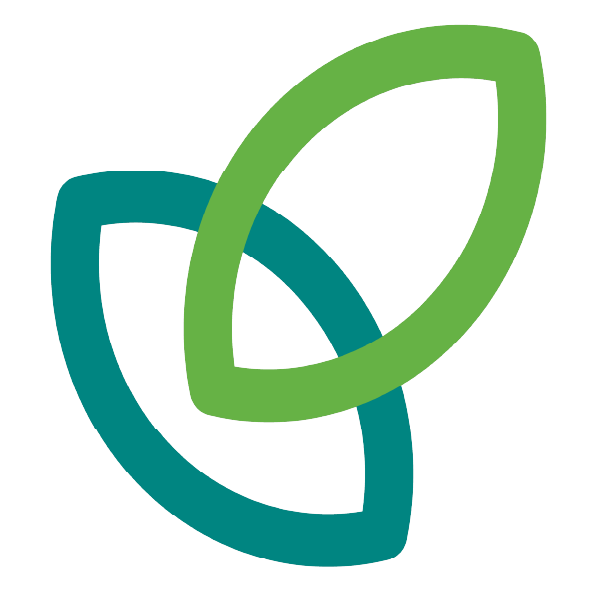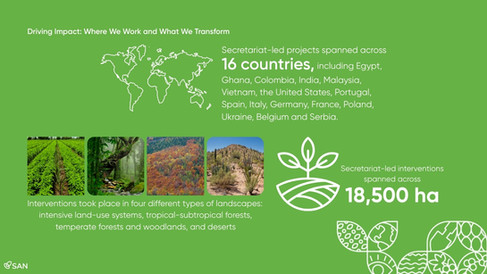Launching SAN’s Annual Impact Report 2024: From commitments to verified outcomes
- Communications

- Sep 6
- 3 min read
Updated: Sep 10
Sustainability. Simplified. We’re proud to share our Annual Impact Report 2024—a concise, data-rich view of how the SAN Global Impact Network is turning corporate and community commitments into measurable results across climate, nature, and people.
What’s inside the report—at a glance
Collective scale, local precision. Our Network Members reported 400 projects in 118 countries with a consolidated USD 645M budget and 5,842 staff (46% women). See the chart on page 14 for the full footprint across 10 landscape types.
Real reach, real people. Member-led programs reached 11.2 million farmers and 8.5 million farms, with 93% of participating farms being smallholder operations and 42% of smallholders women (see the infographic on page 16).

Secretariat delivery. In 2024, the SAN Secretariat managed a USD 13.8M program portfolio, allocating USD 6.4M in the year; 27% of spent funds flowed to local organizations. Our projects spanned 16 countries, covering 18,500 hectares and reaching 8,450 farms; for projects with gender data, 40% of participating smallholders were women.
Capacity building that sticks. Across Secretariat-led initiatives we delivered 54 capacity-building sessions, alongside experimental trials, training of trainers, and farmer exchanges. Network Members collectively delivered 40,338 training sessions to 679,451 participants.
Members' field stories that show what verified impact looks like
Indonesia (Central Kalimantan): Regenerative oil-palm smallholders supported by Kaleka increased soil organic carbon by 50%+, cut fertilizer costs dramatically, and scaled agroforestry across 200+ hectares (pages 21–24).
Honduras (Mosquitia & Olancho): With ICADE, Indigenous Pech and mestizo communities advanced sustainable cacao and women-led coffee enterprises while strengthening local governance (pages 25–27).
Vietnam (Son La): ADC’s nature-based food forests reduced drought losses by 20–35% and increased yields ~25%, while training students, lecturers, and farmers to scale locally (pages 35–37).
Colombia (Planadas, Tolima): CMAS—our Community-Based Monitoring & Assurance System—put performance data in farmers’ hands, pairing ODK data capture with SAN’s iHub so producers can track and improve practices over time (pages 32–34).
These stories are more than pilots—they’re blueprints for scaling regenerative supply chains with investor-grade results.

Why this matters now
As companies navigate EUDR, CSRD and Scope 3/FLAG pressure, the sector needs partners who simplify compliance, verify impact, and scale regeneration. That is exactly how SAN is positioned across our corporate narrative and website strategy: clear value for executives, rooted in science and field delivery.
Our new 2025–2030 Strategy doubles down on four goals: 1) elevate SAN as a global impact network; 2) advance regenerative, climate-smart agriculture; 3) enhance biodiversity and ecosystem services; and 4) empower rural communities with inclusive tools. The “Road Ahead” section of the report and our Strategic Plan align around these priorities.
By the numbers (highlights you can use)
118 countries of member-led delivery; 16 countries directly via the Secretariat.
18,500 ha impacted under Secretariat-led interventions; 18.3M ha impacted via members.
112 supply-chain companies engaged; 55 organizations beyond the Network partnered in delivery.
Read the report. Then partner with us.
Sustainability doesn’t need to be complicated—it needs to be credible. If you’re a corporate leader aiming to cut Scope 3 emissions, prove deforestation-free sourcing, or scale regenerative agriculture, SAN makes the journey simpler, safer, and faster—with verified outcomes you can report.












Comments